|
This page is under construction.
A Royal
'HAAGSE KLOK'

Severijn Oosterwijck
Haghe met privilege
Table of contents:
Type Ctrl+F to find any word on this page.
•
INTRODUCTION.
•
Huygens' authorities.
Huygens'Pendulums
Collections and Exhibitions
DidacticScholarship
Who was Severijn Oosterwijck.
•
General observations.
The Inspection
Originality
Unique
Features.
Plomp's
Charateristics Properties
Comparables
•
PART I
HOROLOGIUM
The Clock
The velvet fronted brass dial plate.
Signature Plate
Chapter Ring
Coster Hands
Dial Latch
Pendulum Holdfast
(Type Ctrl+F to find any word on this page)
 INTRODUCTION
INTRODUCTION
Severijn
Oosterwijck’s, earliest known, spring-driven pendulum clock was first
published by clockmaker-restorer Paul Shrouder Hon.FBHI, ("A Mantle Clock", Horological Journal, BHI, Sept. 2008). He recorded
his restoration and alluded to its history. I recognised its real
significance and contacted the BHI. Subsequently, at Mr. Shrouder’s
workshop, I met the owner with his rare Hague-Clock (NL.Haagseklok).
First I established there were no commercial interests to serve, only
horological and historical ones. I was told that, by family tradition,
cited in Wills, and by descent, this little Hague clock has been in
their family since its gift to their ancestor, with a Knighthood, from
Charles the Second on His Accession to the Crown in June 1660, in
gratitude for financial support in exile during the long interregnum
(1649-1660).
No antiquarian could want for a more tantalizing provenance, nor a more
dynamic period in the early pendulum history. I was not disappointed. It
is one of the earliest known Hague pendulum clocks, and a 'Striker'.

Fig. 1 (click to enlarge)
Oosterwijck's Aristocratic Haagse Klok
(view high res
picture)
Pf.003
●
First
Impressions [Fig.2].
Some
works of art, also clocks, have the power to hold the viewer; this is
one such. At first sight, the regularity and quality of the movement and
the dial presented features and components I had not seen in a Hague
clock. I also observed the evidence of an ancient accident involving
both the case and its movement.
Its
workmanship is outstanding, superior to Coster’s pendulums,
notwithstanding the latter's superb watches and table clocks
in the balance-era. Now I better
understand why, in March 1662, Alexander Bruce (Earl of Kincardine),
then Christiaan Huygens (Monsieur Zulichem)
in 1663, each chose Oosterwijck
to make their Longitude ‘sea-clocks’,
(inherently flawed by pendulum control in first instance), then to add
Huygens’ too complex (also flawed)
weight-remontoir in 1664.
Oosterwijck’s 'Haagseklok' or 'Haagseklokje'
("little Hague clock") deserves the fullest appreciation. Its privileged
owners would remain anonymous, yet know more of their heritage and its
context; the restorer would publish via the BHI, a technical audience
not versed in Huygens; and I would bring this rare Hague clock into the
antiquarian fold, via the Dutch Horological Foundation website,
(www.antique-horology.org), with meaningful images also vital dimensions
to promote new research. Knowing that I cannot succeed equally, I offer
my findings, (PART I, "HOROLOGIUM"), also my historical perspectives and
new hypotheses, (PART II, "OSCILLATORIUM").
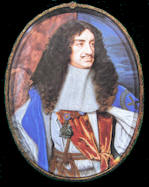
Fig. O2V
King Charles the Second of
England (1630–1685)
 HUYGENS, AUTHORITIES HUYGENS, AUTHORITIES
Readers
not familiar with Christiaan Huygens (1629-1695) and the early
pendulum-era will find the Horological Foundation website invaluable. It
includes a Compilation on the Hague Contract of
September 3rd, 1657, between young John
Fromanteel (1638-1692) and established Hague clockmaker Salomon Coster
(1623-1659) the pendulum patentee appointed by Huygens as inventor. One
long misread, still misunderstood clause alludes to a ‘secreet’, that cannot be the pendulum or crutch which John already
had seen and made. It taxes us yet. This clock may have great relevance.
●
Collections and Exhibitions.
G.B.Shaw once wrote, “if I had had more time, I should have written a
shorter letter!” But gone are the days when Drummond Robertson could
review two neglected Coster clocks in just two paragraphs, (“Robertson
J.D., "The Evolution of Clockwork”, Chap.VI, pp.76-81). Scholarship has
moved on apace, with specialist articles, new reference works;
magnificent Dutch exhibitions, “Octrooi op de Tijd” (Museum Boerhaave,
1979), “Huygens Legacy” (Paleis Het Loo, Apeldoorn, 2004); also great
private collections. Mr H.M. Vehmeyer’s astonishing catalogue, Hans van
den Ende’s museum at Edam -- I was privileged to attend its opening, I
stayed three days! My own study of Hague clocks was helped by many,
especially by the late Willem Hana and the Dutch restorer Mr. L.H.J.
‘Berry’ van Lieshout; many rely on his wide knowledge and unique
archives.
● Didactic
Scholarship.
Professor
Dr. Ir. Reinier Plomp has long been popularising
Hague clocks, by numerous
erudite articles and his standard reference work, “Spring-driven Dutch pendulum clocks, 1657-1710” (Interbook International BV,
Schiedam, 1979). For the privilege extended to me, I presented copies of
Dr.Plomp's book both to the owner also to Paul Shrouder. Lately,
Dr.Plomp has identified “The
Prototypes of Hague Clocks and Pendules Religieuse”, (Antiquarian
Horology, June 2007); he also defined their significant characteristics,
“The Earliest Dutch and French
Pendulum Clocks”, (HF website, Op. Cit.). His matrix is based on 25
clocks, to determine both craft lineages also chronologies (‘D1’, etc.,
for Dutch pendulums; ‘F1’, etc., for French pendulums). Dr.Plomp's
academic and horological credentials place him at the fore, currently he
is about to publish his long awaited tome on "Pendules
Religieuses", the French derivatives of Coster's pendulum clocks.
Here, I follow his line; he may have to revise his chronology.
Dr.Plomp's characteristics’ are not the only ones to be
observed in a Hague clock. Several are too general to be useful; others
too infrequent to compare yet still important. Among these is,
or should be, the unidentified
‘secreet’’ construction– although many have made diverse
attributions.
In
a paper for the Dutch
Horological Foundation, I cited research by Berry van Lieshout and
myself, (HF website, Op.Cit. 2005). Implicitly, on Mayday
1658, a 'secreet' was to be shared between Fromanteel’s and Coster’s clocks.
I pointed out, ‘secreet’ is not a Dutch word at all; “its etymon seems
entirely English; if so what then?” I believe that overlooked etymon
confirms a conspicuous and even important linguistic clue. Might that
contractual secret also be found here in young Severijn Oosterwijck’s
Royal Hague clock?
●
Who was
Severijn Oosterwijck .
Notable authorities, (Robertson, Morpurgo, Edwardes, Dobson, and
Plomp), have cited his life and work. Berry Van Lieshout records,
“Severijn Oosterwijck was born before 1637, son of Adam Oosterwijck
clockmaker of Middleburg (employer of Pieter Visbagh from 1649, after
completing apprenticeship with Salomon Coster); He died around 1694. In
1657, he married a Sara Jans van Dueren at Rotterdam”; [KP. Did he then
know Mr Simon Douw, ingenious Clockmaker of Rotterdam? Already he was a
fine clockmaker, see Huygens Legacy, exhibit 07, balance controlled and
dated to 1655, but curiously bears a Hague signature]. Whereas,
“Severijn is first mentioned in the Hague in 1658, when his first son
Adam was born; he registered there in 1659, first renting near the Spui
[river]; in 1660 he bought ‘De Drie Vergulde Mollen‘ and then took
Pieter de Roo as apprentice”. In 1662, he made two copies of Alexander
Bruce's (Earl of Kincardine) first Longitude pendulum clock fitted with
a double-fork F-crutch, shown to Huygens in London in 1661, both tested
by Captain Holmes. He then constructed Huygens’ Longitude design and, by
August 1664, he also had incorporated Huygens' ingenious but flawed
weight-remontoir, for which Huygens would obtain a Dutch patent; but
chided by Sir Robert Moray, that priority for the remontoir was
[Ahasuerus] Fromanteel’s, he assigned his English Patent (3rd March
1665) to the Royal Society. Robert Hooke had scoffed; he understood that
a pendulum is inappropriate for any sea-clock; as is the weight
remontoir; but inherent defects do not reflect on Oosterwijck’s
craftsmanship. In 1664 Lord Brouncker, first President of the Royal
Society, had one of his seconds’ regulators; Sir Robert Moray in
Maastricht had one too. “Severijn had four, sons, all were clockmakers;
in 1687/8, he and Adam (1658-1695) petitioned the Hague Magistrates for
a Clockmakers’ Guild; and upon its incorporation Severijn became first
Master. Around 1690 he made a year spring movement for Jean Brisson’s
monumental case (modelled on the more lavish Breghtel-van den Bergh case
of 1665-1670, now in the V&A London). Later, with third son Jacobus
(1662-1711), he adapted it into a musical clock, which they signed
jointly”. [KP. It is one of Holland’s horological icons, (see P.C.Spaans
Collection, Lot 421, Christie's Amsterdam, 19/12/07). I saw it with
Eugene Stender in 1976].
Any clock by this particular maker is of interest, and for several
reasons; his part in the birth of the Dutch pendulum clock; his
abilities as a craftsman; also his early part in experimental maritime
navigation to determine longitude by pendulum time-keeping (see Appendix
Three). The subject clock ticks the first two boxes, hence this Royal
patronage; Bruce and Christiaan Huygens himself ticked the third box.
His name never disappoints.
 GENERAL OBSERVATIONS GENERAL OBSERVATIONS
●
The Inspection.
Paul Shrouder took down, measured parts, and counted
teeth, as I made notes and shot images (of variable quality). The
minutia of our record is essential towards a better understand of “the evolution of clockwork”. For researchers, the dimensions and
wheel-counts are recorded at
Appendix One; Appendix Two
touches on conservation needed to preserve this unique case;
Appendix Three offers new
lines for study, and proposes an "open-research"
Web project.
●
Originality.
Antiquarian catalogues rarely reveal the extent of any ‘restorations'. For
the benefit of researchers, my examination
found Oosterwijck’s movement to be very original. The few exceptions
are; the mainspring is replaced; the original four-spoke escape-wheel's
collet and pinion are newly made; the original four-spoke contrate wheel
now has a new collet; the original pendulum-rod has a new bob, it now
also has a suspension hook - (the original pulley mount sadly removed);
door glass is replaced. A restorer’s defacing scribbles infer he moved
the hammer and adjusted its clapper, the strike-lever is untouched One
function has been lost, a strange ‘cam’ on the barrel arbor and vacant
pivot holes offer cryptic clues of a unique feature, (see 'Wind-Me' -
Part.II, "Oscillatorium").
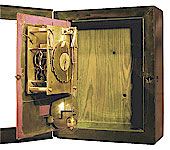
Fig. 2 (click to enlarge)
Oosterwijck's Aristocratic Haagse Klok
(view high res
picture)
Oosterwijck's spring clock has the typical strike-gates
and central countwheel, with early internal bell, but also unique
features like the pendulum holdfast (Fig.2).
●
The Unique Features:
Among Hague clocks, Oosterwijck’s movement has features
that I believe to be unique, namely;
| 1 |
|
Octagonal
pillars. |
| 2 |
|
Fromanteel type strap-potence. |
| 3 |
|
Watch-stop
work
hidden under ratchet work |
| 4 |
|
Its
four-spoke escape and contrate crossings are exceptional.
One
lost feature, an Up-Down mechanism? certainly would be unique
among Hague clocks. |
| 5 |
|
Dial:
a
folding pendulum-holdfast; an obelisk bell-stand; and rare
sector cut-out. [His early 'Lieberge'
clock has a date-sector, (Sothebys Amsterdam 21-02-1995, lot
324), as does his later clock, (Plomp R, Op.Cit. nrs.84)].
|
|
6 |
|
Box-case:
hardwood carcass and backboard is constructed from an expensive
show-wood, used in the solid. My initial recognition of
‘Kingwood’ (Dalbergia
Cearencis) has gained expert support. |
Having early
strike work and a
split-barrel* (one
spring serving multiple trains) also mark it out as special. [*Tandem-barrel
misleads, being two or more barrels serving just one train].
Notwithstanding the cited changes, this is a most
original Hague clock and whilst not
virgo intacta, undoubtedly it
is of huge academic significance. But how does it square with Dr Plomp's
earliest characteristic properties?
●
Plomp’s Characteristic Properties, vis a vis Oosterwijck’s Clock.
|
Windows |
P1. |
Earliest simple box,
no side windows, but sound-holes in base
and side. |
|
Door Frame |
P2. |
Early
plain section; Hinge plates are set into 45 deg. angled
mortices, beneath veneers. |
|
Aperture |
P3. |
No backplate
aperture for escapewheel, (higher escape-wheel). |
|
Pillar Shape |
P4. |
Uniquely Octagonal!
|
|
Holes |
P5. |
2 Steady
holes
but for a strap-potence, (higher verge).
|
|
Key |
P6. |
Winding key also
locks the door, (no special key). |
|
Chapter Ring |
P7. |
Pinned
to dial , (not riveted). |
To
pre-empt conjecture, although the subject clock possesses some of the
very earliest characteristics, it probably falls outside the first
experimental
year, 1657. Significant negatives
include: Dial plate is not made of Iron (unlike extant Coster timepiece,
provisionally ‘D1’, Plomp 34); Dial plate is not fixed, and the case has
no rear door nor removable panel, (unlike Coster timepiece ‘D2’, Plomp
35); Hinges are not combined for the dial and door (unlike Coster ‘D3’,
also Fromanteel's English box-cases); Spandrels were never fitted.
●
Comparables:
Oosterwijck’s 30-hour spring clock
with hour strike is most directly comparable with Salomon Coster’s two
known striking clocks; ‘D8’
and 'D10" in Plomp's
chronology;
<Compare Oblique>
(Plomp R, Op.Cit., Nr.38; “Prototypes”, Op.Cit., Figs.6,7,8).
Oosterwijck's clock even has ’Coster
hands’, rarely seen with another maker.
Coster's
split-barrels have a significantly larger diameter, and have larger
centre pinions, than Oosterwijck's Royal clock, but all have a similar
duration around 30-hours, (see
Appendix One, Table 4). Other than a tortoiseshell frame, the box
case of Coster D8, is remarkably similar to Oosterwijck's case, also
having sound-holes. Probably these two cases were made by the same
furniture maker.
Whereas, Coster's next striker
'D10',
and also Oosterwijck’s next, 'D9'
in Plomp's chronology, (Huygens Legacy, Op.Cit., Nr.11), both
possess more decorative hands, signature plates, cases, mouldings, and
movements; all of which signify later dates. Internally, both D9 and D10
are laid out like the earlier Coster D8, and the subject Royal
Haagseklok. All are 30-hours, on 4-wheel trains; but dispel prejudice,
Huygens himself preferred fewer wheels for less friction.
Coster 'D8'
is presently regarded as being the first Hague clock to have strike.
However, I shall advance a new hypothesis - that Oosterwijck's Royal
clock is the predecessor and is also the pattern for Coster's also
Visbagh's striking clocks. I shall also propose an 'open research'
project - to accept and collate trains and other technical data that may
eventually reveal train evolutions, chronologies, and test new
hypotheses. (see Appendix Three).
 PART
I “HOROLOGIUM”
The Clock PART
I “HOROLOGIUM”
The Clock
The
velvet dial plate
●
Overview
Oosterwijck’s velvet on brass dial plate, (21.2 x
16.5 cm),
is smaller than all but one of Coster’s - a sure indicator of an early
Hague clock. His superb dial even creates the illusion of a Coster
clock, it even has the earliest steel-tipped minute hand and lobed hour
hand, set upon later velvet of Indian-red.
Swivel pins (L) allow the dial to swing outwards.
(Fig.3).
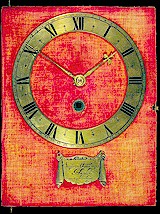
Fig. 3 (click to enlarge)
Oosterwijck's Dial
(view high res
picture)
The
dial retains Coster’s decorative brass winder-collet, that preserves the
velvet. The cannon opening is oddly irregular, but I could not find
evidence for separate alarm work like Coster 'D5',
nor integral like Coster' D8'
added retrospectively. The typical engraved Lambrequin signature plate
covers the dial's access hole, needed to restart the pendulum, but the
old red velvet covering is not cut out. While it
is not the original velvet, it is fragile
so was not removed to examine the plate.
Co-operation
between these two earliest Dutch pendulum makers is writ large. Even
Coster’s immediate successors, Frenchman Claude Pascal and first Dutch
apprentice Pieter Visbagh, rarely replicated Coster hands but, instead,
each introduced decorative piercings.
Early
Dutch pendulum movements are rarely signed, so only its original
signature cartouche denies Salomon Coster the credit for Severijn
Oosterwijck’s rare clock and outstanding quality.
Just
as the iconic square pillars were initially adopted, the velvet dials
saved the great expense of engraving or matting, and also speeded up the
fabrication of these new clocks to meet demand. Nevertheless, velvet
became the reigning fashion for decades in
Holland,
Flanders
and
France,
but not elsewhere in
Europe nor in
England.
Purple velvet,
from the Purpura lapillus
mollusc, was probably used originally; like another Royal patron’s
baroque gilded console-clock by Johannes Van Ceulen, its case is now
attributed to Daniel Marot, (see Turpin A, “A table for Queen Mary’s
Water Gallery at Hampton Court”, fig.14, p.11 p.14, Apollo Magazine,
Jan.,1999). Matching silk replicates the original appearance, while also
protecting the rare original velvet, much worn and faded where not
protected by the mounts to its most unusual Limewood dial in the French
style.

Fig 05v
Purple velvet on a cartel by
Joh. van Ceulen and Daniel Marot.
Black,
or scarlet, velvet cannot be ruled out, but I reason that the Prince
Charles Stuart (soon to be crowned King Charles II) already possessed
his executed father's French tastes and still held to the doctrine of "Divine
right of Kings”. Therefore, an immediate visual impact, showing
His personal clock’s Royal
status, would have been irresistable.
●
Signature Plate. [Fig.4]
The typical wrought and gilded brass
lambrequin plate, now with a pinned repair to one hanger, is finely
engraved (not etched), and bears a full signature, also Huygens’
license;
Seueryn
Oosterwijck Haghe met privilege”.
Note the phonetic spelling of 'Severijn'.
|
Severyn Oosterwijck
Haghe
met privilege |
Early
signature plates hang on wire loops, over a dial access hole for
restarting the pendulum. The hole is present, but the later velvet is
uncut.

Fig. 4 (click to enlarge)
The signature plate.
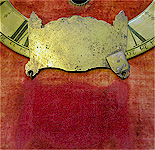
Fig. 4a (click to enlarge)
Velvet is uncut.
Though
it bears no date, here I do not doubt that this is the original
signature plate, probably even sourced from Coster’s engraver; unlike
the repoussé plate of his next clock, (Plomp, “Prototypes”, Op.Cit. D9).
[Van
Lieshout privately suggested that Huygens should not have granted “met
privilege” while Coster lived, he died in December 1659. It is a telling
point, since the assigned Octrooi was granted to Coster for a term of 21
years, so it would require both to consent. Even Pascal's earliest Hague
clocks do not bear the legend.
KP. But, also in 1657,
Huygens did grant a second privilege, to Jan van Call in
Nijmegen, (Morpurgo E.,
"Nederlandse klokken en horlogemakers vanaf 1300", p.30, Scheltma &
Holkema, 1970, Amsterdam);
Berry himself privately records a dated clock by Pieter Visbagh,
bearing the legend “Met
privilege 1659". Even Dr Plomp's chronology puts Oosterwijck 'D9',
bearing the legend, before Coster's similar striker 'D10'. Was Coster,
perhaps, incapacitated? Did Huygens anticipate his decease
by granting the coveted privilege to other Dutch clockmakers?]
Herein, therefore, I shall interpret and assess the subject
Hague clock only against the evidence of extant comparables and their
more authoritative dating. However, in the light of discovery of
Oosterwijck's clock and my new evidence, I anticipate lively
contributions on this point.
●
Chapter Ring [Fig.05].
The gilt brass ring is typically
narrow (2.0 cm), of small diameter, (14.3 >
10.3 cm).
It is finely engraved and very well finished.
Among early Hague clocks, its design represents what I putatively
identify as the 'Fourth-state'.*
Roman Chapters,
I-XII, mark the ordinal hours. Half-hours have become stylised
spring-flowers, now with the
Quarters scribed within the narrow inner band; still with Coster's
enclosed ordinal Minutes shown in fine Arabic ciphers,
1-60, in a wider outer band; each Minute is
scored through in early manner. Seconds’ are not shown, though Huygens
showed how in ‘Horologium’, and Philipp
Treffler’s 1657-8 copy does, (see concluding Perspective
6, A Seconds’ Hiatus).

Fig. 5 (click to enlarge)
Chapter Ring
(view entire chapter
ring in high resolution)
[*I observe, Coster's
'First-state' chapter-rings have every minute scored through,
'arrow-heads' mark the half-hours, there is no inner quarter-line;
the 'Second-state' adds
an inner line, yet without
quarter marks; a 'Third-state'
adds spring flower half-hour markers, still without quarter-marks; a 'Fifth-state' has quarters with arrow-heads now sprouting from base
flowers. Another variation,
is where the single minutes (1-9) are not scored through, like Coster
D3, D8, and D10; D3 anyway has an untypical heavy chapter-ring. However,
any particular 'state' (design) might also depend upon the engraver
chosen, or clients' wishes. Chapter ring styles soon proliferated as
pendulum workshops sprouted across
Europe- I understand Hans van den Ende is
preparing a paper on this subject].
The reverse side, too, is also well
finished but shows tool marks, also an indistinct cipher and a Roman
XII 'scribed at the top
stud. This is the original chapter ring, fixed by integral round studs
pinned at the dialplate.
●
Coster
Hands.
Oosterwijck’s ‘Coster-hands’ are
finely wrought and sculpted in gilded brass. These are the original
hands; despite evidence of maltreatment each retains most of their
original fire-gilding, probably the steel tip of the minute hand was
blued originally.

Fig. 6 (click to enlarge)
The 'Coster' hands.
The
rare moon-pierced minute hand, with early steel tipped pointer (7.05 cm),
is held by a domed collet, having a collar and pin-slot The lobed hour
hand (5.1 cm)
is secured to the hour-cannon
by two transverse pins, (Fig.6a). It is instructive to compare
the subject hands directly with Coster's, which are rarely seen on
another maker’s clocks.

Fig. 6a.
Transverse fixing point, to secure the
hour-hand onto the hour-cannon.
Oosterwijck’s
next extant clock (Plomp D9) keeps Coster’s minute hand, but its broad
hour hand has teardrop* piercing, silvered to match the silvered chapter ring in
contrast to its black velvet dial.
*Teardrop piercing is
also found in his Lieberge
clock, (Appendix Three).
Interestingly, when discovered, Coster D3 possessed an untypically
carved and teardrop-pierced
hour hand, with a short trident tail, more reminiscent of early table
clocks. Is Oosterwijck
recalling Coster's original pendulum hour hand?
<Refer D3hand>
●
Dial
Sector
[Fig.7a]
On seeing the dialplate, already
with its movement demounted, I noticed an unusual opening, an
inverted-keyhole below XII,
in the centre zone. The facing velvet is not cut out. If for display,
like Oosterwijck's Lieberge
clock (see Appendix Three), it would be a rare exception to early practice; I
first took it to be for Huygens’ Seconds’ window, alternatively for the
Weekdays and Deities. It proved a 'red
herring’; when the movement was returned to its dial, the vertical
motion-cock recessed flush into the sector. (Coster D8 has a canted
cock, D10 has none). Had extra
depth for a strike-lever been overlooked? Such oversights might be
significant. I had not seen dial cut-outs for motion work in any Hague
clock, except a French inspired wooden dial plate by Van Ceulen-Marot
(see above)*.

Fig. 7a
Dial sector?
The dialplate also has a typical rectangular access
hole, to restart the pendulum, faced by later velvet, uncut like the
'keyhole-sector' above. Tiny vestigial dial studs might be changes of
mind, clockmaker's 'pentimenti'.
The unique holdfast is shown pivoted to the 'rest' position, held
by a sprung geometric lock sited next to the obelisk bell stand.

Fig. 7 (click to enlarge)
Dial opens outwards on swivel-pins.
(view high res
picture)
* An
early ‘pendule religieuse’, by
Isaac Thuret of Paris, has a similar cut out dial sector, but only
through the brass false-plate which is riveted onto its fixed iron dial.
[Thuret's dial is reminiscent of the earliest extant Costers;
‘D1’ having a pivoted
iron dial;
'D2’ having
fixed brass dial]. Note
the octagonal steel work to a typical vertical hammer post, here
unusually mounted on the dialplate.
●
Dial
Latch
[Fig.8]
The typical Coster pattern fabricated brass
latch, having a broad flattened spring reversing on itself and turning
into a single scroll foot, being riveted behind the brass dial plate.
The latch has a brass slider protruding through a horizontal dial slot.
Coster's many acolytes adopted it. The surprising exception is Coster
'D10' which has a brass latch but a straight spring.
[Fromanteel's English box-clocks
have brass latches with longer ’S’
shaped springs, yet are recognisably derived from Coster]
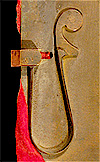
Fig. 8 (click to enlarge)
The 'Coster' Dial Latch.
(view high res
picture)
●
Pendulum Holdfast
[Fig.9]
The exceptional, robust, folding, pendulum-holdfast, pivoting in dial
brackets; its lobed base forms a geometric lock against a broad spring
with “T” shaped foot fixed to
the dial, (with iron rivets, like the repair to signature plate). The
long cranked folding arm ends in a square fork having a delicate
swivel-hook, to enclose and hold the pendulum rod. All edges are
chamfered, it is masterly, and also unique on a Hague clock.
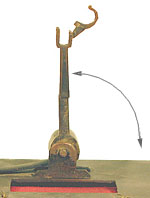
Fig. 9 (click to enlarge)
Holdfast extended, swivel hook
open.
Evidently,
Oosterwijck foresaw that his Royal clock would be moved about, regularly.
[Based on photographs, Van
Lieshout suggests this device is not original, saying if any holdfast
ever was fitted to this Hague clock it may have been pegged into the
backboard, in one of the holes. KP. I do not share his
view. The quality, colour, also the patina of this device matches the
dialplate too closely].
Why
is the holdfast not seen in other Huygens-Coster spring clocks sent to
Italy,
Germany,
France
and
England?
It seems a practical idea, even for a seldom moved spring wall clock. I
suggest it was then envisaged that, once delivered, those clocks would
all live out sedentary existences.
Whereas
this pendulum clock was made for a
Royal Court which, in the changing
fashion of the time, still was often in progress around the realm to
enjoy the hospitality of liege families. Evidently, this clock was
intended to be included in every Royal baggage train.
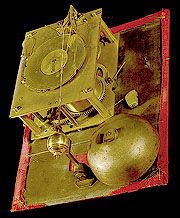
Fig. 9a (click to enlarge)
Oosterwijck's Aristocratic Haagse Klok
(view high res
picture)
 THE MOVEMENT PROPER. THE MOVEMENT PROPER.
●
The
Plates
[Fig.10]
The rectangular plates (11.5 x
9.4 cm)
are conventional, any original gilding is now fugitive. Notches (V
- \ /) in the top edges
reveal intended orientations which were ignored when being drilled, (see
fig.15b). That simple oversight had no further consequences.

Fig.
9b
Notches in the plate edges.
The
one-piece front plate is rebated at the left edge for the return of the
drop-hammer; whereas the striking Coster frontplate (D8) has no cut-out
because spacing is greater and its hammer stem is straighter and its
steel clapper is itself rebated. Oosterwijck's front plate has two brass
studs to locate the trapezoid bridge of motion work. [Note. Coster D8
has integral studs on the bridge itself].
A
central steel hammer stop-pin has been made redundant by the hammer
move. There is a steel steady-pin to the left, possibly for a cock to a
lost device (see "Wind-me").
In the lower right corner is a, now misformed, "L" shaped, brass hammer
spring - to assist the gravity drop-hammer.

Fig. 10a (click to enlarge)
Frontplate obverse.
(view high res
picture)
The
thick brass 'L' shape
hammer-spring is held by integral steady-pins being pressed into the
plate, its long tail is now reshaped, curled oddly upwards, again caused
by the hammer being moved. Between the central pivots at the lower edge
is an internal post, now reduced.

Fig. 10b (click to enlarge)
Frontplate reverse.
(view high res
picture)
Four,
unique, octagonal pillars are riveted to the plate, giving 3.8cm separation;
1.5mm wider than Coster's D1-D5 plates, but exactly according with
Huygens's spacing, "one and
one-half inches apart", ('Horologium
Oscillatorium', p.15).
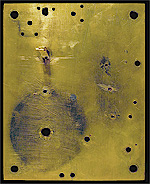
Fig. 10c (click to enlarge)
Backplate obverse.
(view high res
picture)
The
single back plate is undecorated and also
is unsigned, usual for all first-period Hague clocks, (compare
his next clock, see Plomp D9, 'Huygens
Legacy' Nr.11).
I should
want to planish out both of the 1970 restorer's accusatory inscriptions,
this (under the count wheel)
defaces the plate.

Fig. 10d (click to enlarge)
Backplate reverse.
(view high res
picture)
The back plate has a central steel stud for the
count-wheel; the brass detent-spring is held by integral studs. The two
small holes adjacent to the detent position are probably for the
spring's first plant which Oosterwijck
then changed.
Riveted inside the back plate is a long brass post of
the lower potence, having dovetail jaws holding a steel wedge - to bear
the vertical escape pivot.
Both
the verge cock and the upper strap potence, have integral steady-pins.
Individual pendulum suspension ‘cheeks’ are screwed high on the plate.
Original tool marks abound, some finishes remain; Paul Shrouder has
conserved these all.
Plomp suggests all the extant Coster timepieces, all
having regular plates (109/110 x 58/59 mm) and square pillars, were in
fact all made by young John Fromanteel. Whereas Coster’s first
striking-clock ‘D8’ required larger plates (120 x
98 mm), like Oosterwijck’s similar ‘D9’,
(117 x
95 mm); both similar to the subject plates (115 x
94 mm).
Is that mere co-incidence or had Oosterwijck the access to
Coster’s workshop, therefore to young John Fromanteel, and thus to new
developments in
England, even to shared ‘secreet‘ construction? Suddenly, attention to every detail
in this clock became paramount.
●
Octagonal Pillars
[Fig.12]
Four octagonal brass pillars
(3.8 cm
‘tween plates), are proudly riveted at the front plate and pinned at the
back plate, without flourishes.
Note the early strike-detent 'gates'.

Fig. 11 (click to enlarge)
Octagonal Pillars
(view more on high res
picture)
These
recall square pillars, used by Coster, also Ahasuerus Fromanteel
(1607-1693) in
England,
to reduce time and costs in bringing their pendulums more quickly to
ready markets. A Coster balance-wheel table-clock has hexagonal but
twisted pillars, also square dial-feet, (Vehmeyer,
Op.Cit, Pt.II, Chapt.2,LC7, pp.274-5).
Square pillars are uncommon, but several earlier ones are known,
(Vehmeyer,
Op.Cit, Pt.I, pp.140-161; by Johann Sayler of
Ulm,
(G23, G24, G25); by Andreas Raeb of
Hamburg,
(G29); and lastly in 1651, by Jacub Gierke of
Vilnius,
(G33). On the evidence of Coster's table-clock (LC7), I am inclined to give him
the credit for deciding on time saving square pillars for Hague pendulum
clocks
Whereas
Coster acolytes around
Europe all adopted round pillars, here, Oosterwijck seems to take his lead from
‘Fromanteel-Coster’ square pillars. Curiously, Oosterwijck's ‘Huygens-Thuret’
style long-pendulum regulator has heavy square pillars. (Sotheby's
New York,
13/10/04,
"Time
Museum",
Part.4, Vol.1, lot 518); now in a Dutch private collection.
<Refer_Regulator>
Early
Ahasuerus Fromanteels often have octagonal dial-feet, like his
roller-cage clock at the Museum of the History of Science,
Oxford. Whereas, Coster's Hague
clock dial feet are mostly round; except ‘D8’ having hexagonal dial
feet, and 'D5' having square dial feet like the pillars to its movement
and separate alarm. However, I do not know of another Hague clock having
octagonal pillars; octagonal steelwork is more common.
<Refer_Thuret>
Oosterwijck’s octagonal pillars
probably gave him subtle savings in costs and time, to fulfil his Royal
client’s order for a new Huygens' pendulum clock, but having a visibly
superior movement and the additional novelty of hour striking - but no
alarm. King Charles left
the Hague in May 1660, for
England and His Coronation, we may now presume, with His new
striking
Hague clock in His luggage.
Pf.036
●
The
Motionwork [Fig.13]
The wrought brass bridge, notched with a ‘V’
matching the front plate, its trapezoid feet planted on brass studs
set into the front plate and fixed by
screws. (Fromanteel’s early bridges are also set on plate-studs, later
ones have integral steady pins).
Coster D8 has a rectangular bridge,
Coster D10 has none.
<Compare Frontplates>.
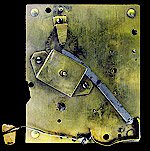
Fig. 13 (click to enlarge)
The motion work.
The
up-stands to the wide bridge are slotted for the reverse-minute wheel
and the strike lever. The cannon is plug-riveted into the bridge. The
wrought brass vertical cock of the reverse minute wheel, with integral
steady-pins is fixed by a dome-screw, it recesses flush into the dial
sector. The frontplate motion work gearing (32_32/6_72) is identical to all
the extant Coster’s, but Oosterwijck's ten strike pins and countwheel
pinion are unlike.
A
hooked barb to a original long, steel, strike lever is tripped hourly by
a pin on the centre minute-wheel. The weighted, strike-lever (Coster D8
is thinner steel, D10 is brass with a return spring) goes diagonally
across the front-plate to the lower of two plain arbors, to pivot the
arbor of the scroll pinwheel gates, all crafted in steel.
Shown
here the hammer arbor is wrongly planted, its brass clapper has been
moved along its own integral dovetail shaft to extend its reach, the
long tail of the hammer spring has also been reshaped. (Coster D8 and
D10 have flat steel hammer shafts, with steel stop and assist springs
mounted above and below the hammer pivot).
This
form of simple hour strike, now regarded as English striking, is also
the model for two striking clocks signed by Salomon Coster, D8 also D10;
also for Pieter Visbagh's D18. While their details vary, their general
layouts are the same.
 THE FOUR-WHEEL TRAINS THE FOUR-WHEEL TRAINS
Overview
Oosterwijck’s movement breaks new ground, firstly in having a new
‘experimental’ split-going-barrel driving its two trains. I have yet to
see this on device any earlier European going train, where the former
practice was to reserve barrels for striking work, and to always apply a
fusee for the going.
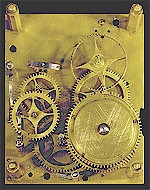
Fig. 14 (click to enlarge)
The
four-wheel trains.
(view high res
picture)
Other wheels have similar evidence of marking-out by
punch or radial scoring, by which I
was
able to show that the abused contrate is the original. Domed brass collets
to the centre-wheel, crutch, warning-wheel and the last strike wheel are
all originals. Dutch trains are usually ‘scribed,
Gaan or ‘G’ (going) and Slag
or ‘S’ (strike); here a single ‘S’ is 'scribed, oddly enough, on the
unmistakable warning wheel.
The rare four spoke contrate and escape wheels are exceptional in any
Hague clock, (see Figures 13 and 15d);
the Hague clock
standard being just three
spokes.
Several
teeth exhibit normal deformations and wear, (see Figure 13a), but
scarred edges to the centre teeth, also the scarred pin-wheel, warning
wheel and escape wheel crossings probably, are all due to the trains
running-on from plate derangement in the accident cited. None detract
from the Royal clock's normal functioning.
[Fig.14a]
However,
I dismiss these as 'age-marks' which do not detract from originality nor
academic interest. Horologists will find the wheel-counts and useful
dimensions at Appendix One,
also two comparable Coster trains of
timepiece D3 and striker D8.
 THE WATCH (GOING) PART THE WATCH (GOING) PART
Pf.038
●
Overview:
[Fig.15]
The four-wheel going-train is planted vertically above its spring-barrel,
like the Coster’s timepieces and his comparable striking clocks (Plomp
R, “Prototypes”, Op.Cit. p.202, Fig.8).

Fig. 15 (click to enlarge)
Going train.
(view high res
picture)
Oosterwijck's
centre-pinion is driven from the rear going wheel, like Coster's trains,
but his is now detached from its centre-wheel which is planted at the
front plate and fixed to the centre arbor with a double-domed brass
collet; Déjŕ vu, Fromanteel!

Fig. 15a (click to enlarge)
Centre wheel.
The tapered centre arbor, with centre wheel displaced
from the rear pinion, is a new feature for Hague clocks. The deep
filed (not turned) relief suggests an
ad hoc revision by the
clockmaker to correct
too small a clearance for the split-barrel strike-wheel (S1).
Probably, in that distant accident the front pivot of
the verge was damaged, re-cut and given an extended bushing to
accommodate the shorter, now re-cut, front pivot (see Fig.15b). The
open screw holes are for individual cocks to Huygens' cheeks (to
eradicate any circular error and to hold the silk suspension).

Fig. 15c (click to enlarge)
Verge frontplate bearing.
Both
the contrate collet and the escape collet are replacements; the escape
pinion of five replaces a badly worn original. The potences, verge-cock
also two suspension-cocks are all the originals. The deformed four-spoke
contrate wheel was painstakingly reshaped by Mr.Shrouder. Though abused,
and recently repaired, nevertheless it is the original. My proof of
originality being, its hand-cut teeth, individually marked out by punch,
and having double-ringed rim.

Fig. 15d (click to enlarge)
The double ringed contrate wheel with hand-cut theet marked out by punch.
Accidental damage also caused the escape wheel’s thick
toothed-rim to be re-cut. Extensive scarring to the rare original
four-spoke crossing and potence are clearly evident in Figure 15d.

Fig. 15b (click to enlarge)
The escape wheels' four spoke crossing.
Again I stress, in any Hague clock, having four spokes
to the upper going train is exceptional, the ‘standard’ is just three. Dr Plomp has privately confirmed that he
recalls one other, by Claude Pascal, (Vehmeyer H.M., “Clocks, Their Origin and Development 1320-1880”, Vol.I. Pt II.,Chap.2, LC14,
pp.288-9).
Conversely, in Ahasuerus Fromanteel’s early
pendulum
oeuvre three spokes are infrequent, although the original strike
train of his most famous
pre-pendulum Chef d'Oeuvre,
(a Solar-Zodiac-Musical clock, made in 1649 for Dudley Palmer of Grey's
Inn, the most famous clock of its time), includes
three-spoke wheels on high
domed collets. [Original
cross-beat and remontoir trains were the subject of early conversion to
a pivoted verge pendulum with remarkably small,
uncrossed, contrate (7/28) and
escape (8/11) wheels].
We
may assume, therefore, that John Fromanteel’s use of three spoke going
wheels, in
Holland, was copying Coster’s
pattern, under contract. Oosterwijck’s independent use of four-spokes,
in his upper going train, together with his novel centre arbor layout,
and strap potence, might all infer an unknown and earlier connection to
the Fromanteels in
London, or a knowledge of their clocks.
Early
Hague clocks did evolve very quickly; a minor consequence of early hand
cutting is that the upper wheels are often larger, with fewer teeth,
having coarser pitch, than later engine-cut equivalents. Trained
watchmakers, like Coster, had their own standards - but the early
conversion of Fromanteel's Zodiac clock has 7/28 and 8/11.
Another
consequence of their rapid evolution is even Coster’s going trains are
not uniform. (see Appendix One,
Tables 4, 5, also Appendix Three, matrix). Oosterwijck’s train
relates directly to
Coster’s
timepiece ‘D3’ and striking clock ‘D8’; their escape wheels are 5/27 and
5/29, Severijn’s is 5/27; Coster’s contrates are 5/64 and 5/60,
Severijn’s 5/60. Such similarities are not by chance; they even hint at Severijn’s going train
being a transition, ie. between Coster ‘D3’ and ‘D8’. It is compelling
evidence, but of what; fraternal co-operation or industrial espionage? I
prefer the first.
Future
researchers may give greater weight to the evidence of wheel-counts and
train designs, to determine origins and chronology. Here I give credit
to Dr.Jeff Darken and the late John Hooper who recorded all wheel trains
in their book, “English 30 Hour
Clocks”, (Penita Books, 1997). Those typical English trains have
upper pinions of 6 or 7, even 9, whereas Renaissance pinions of 5 are
typically found in early Hague clocks. Berry van Lieshout has long
recorded the details of their trains, in his unique database, notes,
images, also AutoCad layouts; but he also adds a caveat, "the demands of
any train may well give identical and yet independent solutions".
Nevertheless,
it is possible to deduce much from wheel-counts, also wheel forms.
Arbors and collets too can reveal lineages. Coster ‘D1’, ‘D2’, ‘D3’ ,
‘D4’ also 'D8' all share
integral steel collets at the front of the centre arbor; whereas 'D5'
does not; only the barrel-arbors of
'D3' and ‘D4’ extend beyond the back plate, only 'D4' has a
turned flourish (like Reijnaert's pillars). Coster ‘D1’ and ‘D3’, have
square collets, behind the contrate; Coster ‘D4’ has a shapely
French collet at the front.
And Coster D3, alone, has a dovetailed barrel-cap; also thinner and
unrounded ends to its pillars; and when discovered an unique hour hand
with an open teardrop trident pointer - not out of place on a
Renaissance table clock. There is an abundance of similar unpublished
data with Van Lieshout and others, therefore I propose an
Open-Research project under
aegis of the Horological Foundation from data inputs by owners, curators
or restorers of early clocks, (see
Appendix Three and
'open-research' matrix).
●
Astronomy's Pendulum.
Huygens was fully aware that the real kernel of his intellectual property,
which he assigned in Coster’s June 16th 1657 Patent, was his
crutched verge, that regulates
his clock directly from astronomy’s freely suspended pendulum, loosely
held within the jaws of his patent crutch. It was a simple construction,
yet a profound insight. He deserved his glory.
Yet
Huygens’ way was very unlike Simon Douw’s
spring-remontoir
with a beam balance,
(cross-beat?), which he and Coster had failed to quash in their
ill-motivated 1658 litigation. Huygens’ way differed radically from, and
was far superior to, Galileo’s pivoted pendulums (1635 and 1642); better
too than Fromanteel’s pivoted pendulum. However, by 1664, even Huygens
had acknowledged Fromanteel’s “new
way of long-pendulum”,
which then founded the long English ascendancy. [Fromanteel’s equation
clock at Belmont reveals an early conversion from the original verge
long-pendulum circa 1662, firstly to
cross-beat pallets on a saw-wheel
(Burgi’s third cross-beat) circa 1664, before its third incarnation
as, so-called, ‘original
anchor' circa 1670 - now with an even later overhead regulation].
Oosterwijck’s original Huygens-type pendulum rod, in
Mr.Shrouder’s images (HJ, Op.Cit. p.382, Photo2), then still retained a
small, flattened, bracket plate at the top. He made a new brass bob, but
he also replaced that tiny bracket with a hook; more appropriate for
later Hague clocks and French variants. Yet that tiny vestigial bracket,
certainly, had once held a small shrouded pulley, for the
silk-suspension. Few Hague clocks now retain it, now known only to
Huygens' scholars and Hague clock specialists, I have not seen it in
Pendules Religieuses. But it
can be seen in Huygens’ original 1657 Patent design, (ie. Figs.I, II,
Horologium Oscillatorium,1673);
also in Perelli's 1770 drawing of J.P.Treffler’s 1657/8 copy of Coster’s
clock (Plomp. Op.Cit. Fig.9); also in Isaac Thuret's regulator
(Vehmeyer, Op. Cit., Vol.II., Part II., Chap.5. pp.810-811, F20). This
seemingly inconsequential part, actually serves an empirical purpose, it
spreads and flattens the suspension chords to squarely meet the face of
the cheeks. Lack of it gives a twisted strand prone to banking. [Its
ultimate expression surely was in Huygens' triangular pendulum].
Happily, when I first saw the clock, Paul had kept the removed part so,
eventually, it might be reconstructed.
● Crutched-Verge.
Oosterwijck
uses Huygens’ patented crutched-verge. The accident-reduced steel verge
is pinned to its brass crutch through the collar of a domed brass collet
unlike the steel block of Fromanteel's pivoted pendulum. Refaced pallets
are set in boxes on the verge; similar pallets are to be seen in other
Hague clocks,
so this appears to be the original verge.
The long stem of the thick brass crutch is bent
outward and forked, to accept the round iron pendulum rod.
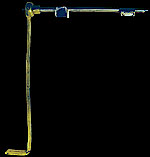
Fig. 16 (click to enlarge)
Hyugens' crutched verge.
The
unusual open fork has two transverse pin-holes, unique in my experience.
Their purpose must be to contain the pendulum, like Coster’s loop, but
probably easier for making, also for attaching the simple rod pendulum -
without the later flat section.
The
crutch was the true intellectual core of Huygens' pendulum invention,
patented by Coster, and used
here by Oosterwijck with both their consents, as evidenced by the
legend, 'met privilege'.
[Van Lieshout suggests these may be English
book-pallets, inferring their
replacement post accident?
KP. I suggest any competent
repairer would not repair a broken pivot, add a new form of pallets,
only to then extend the front bushing to accept his shorter verge].
●
The Verge-Cock.
The
wrought brass, single-foot, verge cock has integral steady-pins, fixed
by a single screw. It is planted at left, opposite the internal strap
potence. It is the original cock, but its form, size and position is
unlike any Coster clock, (or Hanet, Pascal or Visbagh); with the
significant exception of Coster's first striker D8 which also is on the
left, but has a trefoil foot. (Coster's timepiece alarum D5 has a
double-foot, back cock like
Fromanteel's, but it appears to be a French reconstruction). The subject
clock's recent conservation and corrected verge alignment has left an
extra pivot hole from a poor repair when broken in the cited accident.

Fig. 17 (click to enlarge)
The verge cock with integral steady-pins..
Like
Hague clocks of all periods, this verge pivot has not the benefit of
Fromanteel’s earliest steel-shim,
roller-cage, or
steel knife-edge; being his trademark attention to details towards
perfection.

End
of this section, click
here to continue.

 back
back
|
(Table of contents
continued)
•
The movement proper.
The Plates
Octagonal Pillars
The Motionwork
•
The four-wheel trains.
•
The watch (going) part.
An Astronomer’s Pendulum.
Crutched-Verge
The Verge-Cock
Suspension Cheeks
Strap Potence
•
The strike part.
Strike ‘Gates’
The Fly
Count wheel, Detent and Spring
Hammer
Bell on Dial
Split (Going and Strike) Barrel
(the strike part??
Ratchet-work
(the strike part??
Stop work
(the strike part??
Concealment
(the strike part??
The ‘Wind-Me’ Option?
(the strike part??
•
The unique
box case
•
First Assessments.
•
Dimensions and construction.
•
PART II
OSCILLATORIUM
Perspectives & Hypotheses
•
Concluding Perspectives.
Coster’s Other Contracts?
Makers of Coster Striking Clocks?
Fromanteel Connections?
Hidden ‘Secreet’ Constructions?
Personal Associations?
A Seconds’ Hiatus?
Claims to Priority.
•
Sebastian Whitestone's discovery.
Reflecting on the
1657 contract
•
General Conservation
Issues &
Valuation?
Oosterwijck's Box Case
•
Open research
projects.
Early pendulum clocks
matrix
Significant
early makers
Comparable Wheel Trains
•
Acknowledgements.
•
Oosterwijck
Bibliography.
•
Picture Gallery
(the author's original untouched pictures)
 Back to end of previous section.
Back to end of previous section.
●
Suspension Cheeks.
Huygens' famous ‘Cheeks’ were not
part of his design, he claimed for Christmas Day 1656, (Plomp R, Op.Cit.
Fig.4). However, he quickly identified circular-error (periods of oscillations varying, due to the changing amplitudes of
fixed-radius pendulums) that Galileo and Wendelin had observed, but
had not resolved. Seeking to cure that significant defect by empiric
means, early in 1657, Huygens first arrived at cheeks to change the
radii of a suspended pendulum with changing amplitudes, to minimise
circular error.
Huygens'
privilege also extended to
Oosterwijck using pre-cycloid cheeks, evidently without any allegation
by Coster or Huygens of plagiarism or litigation: which indicates to me
their full cooperation in this English Royal commission.
Oosterwijck's two laminae (Cheeks) are set
higher on
the back plate than Coster's. Each separate cheek has a round cock (foot), fixed by
elongated ball-head screws, joined at their contact point by a single
screw clamping the thread. These original unmodified cheeks are an
incredible rarity. [Van Lieshout identified the baroque Van Ceulen
repeating movement as another, no less rare in that later period].

Fig. 18 (click to enlarge)
The pre-cycloid suspension cheeks.
Each cheek has two pinholes at its lower end, I had not
seen that before although Coster ‘D1’ does have single larger holes at
the top. Paul Shrouder neatly resolved these pinholes, by threading the
silk suspension so as wear occurs new thread may be pulled through.
Oosterwijck’s
suspension cheeks already display his empiric form but are, technically,
still ‘pre-cycloid', like
Huygens' original 1657 timepiece (see 'DŘ1' below) and, oddly, still
depicted in Horologium Oscillatorium (Part I, Fig.II); a true cycloid
form is also shown, (Pt.I, p.21, Fig.2).
[Note.
Huygens' original and patented Seconds' clock had his suspension cheeks,
but he abandoned cheeks in subsequent 'OP' design, intended to reduce
its half-second pendulum arc to eliminate circular error (Horologium,
1658, Op.Cit.). By 1660,
he had determined its ideal shape was a
Cycloid. Probably, some cheeks
were reshaped retrospectively; or even replaced (like D8) but his
geometrician’s, incremental
evolutes, proof was only
published in 1673; he credited
Christopher Wren as the first to determine the cycloid's arc-length,
('Horologium Oscillatorium',
Op.Cit. Part II, Proposition xv, and Part III, Propositions VII,
IX)].
●
Strap Potence. [Fig.19]
Dr.Plomp regards the simple verge-cock as an English tradition (Plomp R,
“Earliest”, Op.Cit. Conclusions, pf.3). He says nothing about the
typical Dutch escapement 'potence
block' (riveted or screwed) used since Gerardus Vibrandi's time -
derived from earlier German watches. Pertinently, Coster was firstly a
trained watchmaker, who later took to making table clocks before Huygens
fortuitously offered him his pendulum Patent and rights.
Oosterwijck's
four-wheel train’s high escape wheel and extra long verge does not
follow Dutch practice. He has resolved his higher geometry with a
strap-potence, of wrought brass, mounted on the going side, its foot
fixed by integral steady-pins and a screw; its curved pivot-arm bends
under the verge to the escape wheel’s top pivot. This part, too, appears
to follow an entirely English tradition.
I
believe this strap form is unique among Hague clocks. His novel strap
potence has an external screw, which enables the escape wheel to be
detached without needing to separate the plates.
It seems much closer to the English form adopted by the Fromanteels
for their horizontal verge with pivoted-pendulum, ie. suggesting a
contemporary English pendulum existed.
Déjŕ vu, Fromanteel!
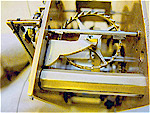
Fig. 19 (click to enlarge)
The cast strap potence.
●
Post Potence.
The lower potence is a long, tapering, brass post, riveted into the back
plate, having inferior dovetail jaws holding a steel wedge to bear the
escape-arbor's pivot. [Coster's lower strap-potences all have similar
dovetails, D1’ and ‘D4’ still have steel pivot wedges, ‘D3’ now has a
brass rivet through the dovetail].
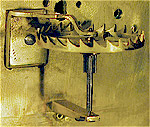
Fig. 19a (click to enlarge)
Escape Wheel and 'English' Potences.
Oosterwijck's might be mistaken for English potences;
that might prove significant. Among Hague clocks this is an isolated
even unique, appearance of the upper strap-potence Ahasuerus Fromanteel
favoured, (Lee, Ronald A, “The
First Twelve Years of the English Pendulum Clock” 1658-1670,
Exhibits 3,13,30).
Whereas all ‘Costers’ and his acolytes' clocks have the
typical Dutch riveted escapement block, with a lower strap-potence,
Fromanteel's distinctive potences had originated from the English
vernacular lantern clock. [Note. as happens in research, I have learned
of a second Oosterwijck movement with a strap-potence, and a fusee,
(exceptional in early examples). After 1680 some Hague clocks were
fitted with fusees, as, by then, several English makers, Joseph Norris,
the Fromanteel brothers, and Steven Tracy had set-up in Amsterdam and
Rotterdam; they first adopted Hague going-barrels but later introduced
fusees as standard, even with Cheeks - "when
in Rome"].
However,
Coster's form is also seen in the rebuilt dated Fromanteel, (Plomp R,
Op.Cit. Fig.22), yet Simon Bartram’s pendulum watch-clock now has
Fromanteel’s strap-potence, (see “Horological
Master-works”, Exhibit 6, AHS,
Oxford, 2003). However, the authors
cite evidence of a “Dutch type top
stud [potence] as illustrated by Huygens in Horologium Oscillatorium
which carried the crown wheel and front verge pivots". A caveat to
those who would impose their own agenda.
Among
Huygens' many sketches and diagrams, only one depicts a strap-form top
potence, (see Horologium,
Fig.1, Sept.1658). Uniquely intended for Huygens' verge-pendulum, was
that strap form known to him from an English model, or from
Oosterwijck’s extant clock? The latter might suggest that his design was
only prepared after seeing the subject Royal clock; the former implies
that Fromanteel’s pendulum, in fact, was contemporary with Coster’s, or
earlier?
When
Oosterwijck made his Royal striking-clock it was
‘state of the art’, and approved by Huygens, certainly not a pirated
copy. His next striking clock (Plomp D9) has similar cheeks but these
(now) mimic the true cycloid shape. (see
Huygens’ Legacy, Op.Cit.
nr.11, p.35); the authors date that lavishly decorated clock, “c.1660”.
Here I stress, it is exceptional for any extant Hague clocks to have
original also unmodified cheeks. So many cheeks
have been
modified, improved or even added, mostly during commercial restorations. When discovered, even Coster D8 had Fromanteel's imperfect pivoted
verge-pendulum escapement; Dutch pride has required its present Huygens'
escapement to be reconstructed. [Conversely, superb English turntable
clocks by East, Matcham, Ebsworth, all recently found in
Europe, had all been converted to
Huygens' improved
escapement].
<Refer Ebsworth>
 THE
STRIKE PART THE
STRIKE PART
Huygens
had always disclaimed striking systems as being already well known and
not part of his invention, (Horologium, 1657, p.15). Here I can find no
evidence for any case mounted alarm work, unlike Coster 'D5', nor an
integral alarm such as was added to the plates of Coster 'D8'' by a
different yet contemporary hand. But, this is one of the first Hague
clocks to have striking, if not the first!
Like
Coster’s extant striking
clocks, Oosterwijck’s clock
strikes the full hours only, not the half-hours; now called ‘English
striking’. Like Coster’s, his 4-wheel strike-train runs diagonally
across the plates, (see Fig.13 above); Dr.Plomp suggests that Coster
'D10' is “actually a timepiece with a striking train added”, (Plomp R,
"Prototypes", Op.Cit. p.202, Fig.8). Curiously, for that decorated,
therefore later clock, D10's plates (109 x
84 mm)
are smaller than the earlier
D8 plates (120 x
98 mm), and are also smaller than the subject Oosterwijck's plates (115 x
94 mm).
It needs considering.
Is
there an anomaly here? It would seem so, generally smaller is earlier.
Only the plates of Pieter Visbagh’s first known Hague clock, circa
1659/1660, are smaller ('D18’ at 100 x
78 mm). Might Coster 'D10' be using early plates, set aside then used later? Or
is it new evidence of sparing expensive materials? We may expect
anomalies. Here I suggest, if Oosterwijck's subject clock had lost its
signature plate, then its dimensions, plain gate arbors and steelwork
would now see it lauded, indisputably, as
‘earliest’
in Coster's striking clock chronology. [One Johannes Van Ceulen
clock suffered just such a misattribution].
● Strike ‘Gates’.
Hague
clock strike-gates, (or warning and pinwheel detents), are relics of
their Renaissance table-clock antecedents.
A long weighted steel strike-lever goes, from its hooked barb at the
minute-wheel, down and across the front-plate to the lower of two plain
arbors bearing the original scroll gates crafted in steel, mounted
across the plates.
Oosterwijck's
gates are of scroll form, on simple round arbors, and are comparable to Coster's - but being on plain arbors are earlier.
Among comparables, Coster's 'D8' has more central reversed 'C' scrolls,
set upon decoratively turned arbors, with plain locking detent and steel
spring - now with replaced fancy detent and spring, like subsequent
striking clocks by Oosterwijck, Hanet, Pascal, and Visbagh. (Plomp,
“Pendulums”, Op.Cit. nr. 38). Coster 'D10' has even more ornate gates,
and bolder baluster arbors, also an untypical (if original) rudimentary
steel spring to a stubby angular locking detent. Details differ, but
layouts comply.

Fig. 20 (click to enlarge)
The strike 'Gates'.
(view high res
picture)
Evidently,
in their pendulum clocks, the English makers omitted these strike gates.
Even Claude Pascal’s first gates are rudimentary; but subsequently,
Dutch and French gates soon became most elaborate, later becoming
vestigial, finally discontinued after 1700.
●
The Fly.
[Fig.21]
A
heavy, cast-brass, lozenge (Rhombus) section fly is held by a narrow
leaf-spring, slotted across its edges at the rear pivot. Its arbor has a
5-leaf pinion. This heavy
fly's inertia, also momentum, must be considerably more than any
thin-vaned fly.

Fig. 21 (click to enlarge)
The heavy cast brass fly.
This same lozenge fly is also found in the
seventh Coster ‘D10’.
Coster ‘D8’ has an unreduced profile with a wider open section,
to further reduce the fly rotation speed with its 6-leaf pinion? Coster
fly-chronology seems reversed but Dr.van Grimbergen, director of the
Museum of the Dutch Clock,
Zaandam, suggests that Coster 'D8' had originally possessed a 5-leaf pinion. Was
its consequently slower fly then a lozenge? Van Lieshout suggests the
subject fly-pinion, of 5 off 48 teeth, is unusual; he also suggests its
heavy lozenge fly was probably to counter a stronger, second, mainspring
post-accident.
KP. In view of the clock's
long English provenance, why does its Rhombus fly exactly match
Coster's lozenge on ‘D10’, and be so similar to Coster 'D8' too? I
regard these facts as clear evidence of an uninterrupted single-path
evolution].
●
Count wheel, Detent and Spring.
[Fig.22]
The
long front plate strike-lever, with a large barbed drop, resembles
English lantern clock practice. Like early Fromanteel also Knibbs, the
lever is directly tripped at the minute-wheel, not from the
reverse-minute wheel.
The large central count-wheel (7.2 cm
diam.) is set on the back plate, mounted onto a central steel stud
secured by a circular brass key-plate. It has a flat profile, it is
un-numbered and ringed, being controlled by a simple steel detent having
a looped brass spring. Vacant holes below the detent were possibly for a
trial or prototype spring that obstructed the operation.

Fig. 22 (click to enlarge)
Count wheel, detend and spring.
A thick round brass spring, is fixed to the back plate,
held by integral steady pins, its reversed tail tensions the spur of the
vertical locking-detent; like Coster D8. Whereas, D10 has much smaller
detent and spring components.
<Compare Backplates>
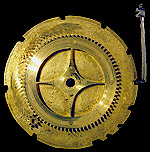
Fig. 22b (click to enlarge)
Riveted to the reverse of the count wheel is a large (5.0 cm) four-spoke
wheel with 78 teeth, driven by a small brass pinion of 10* leaves set on
a squared pinwheel arbor,
(view high res
picture)
Riveted to the reverse of the large count wheel is a
four-spoke driving wheel of 5.0cm diameter. having the standard 78
teeth, but driven by a small brass pinion fitted onto the squared end of
the pinwheel arbor and having only 10*
leaves (see Figure 22a). The pin-wheel too has only 10* steel pins. The warning wheel has two brass pins, one pin being
re-sited by 18mm, probably due to the cited accident. I suggest the use
of tens is evidence towards an earlier chronology.
*Evidence for chronology?
Coster ‘D8’ and ‘D10” each have 12 pins and 12-leaf
pinions, not the Royal clock's 10' pins and 10-leaf pinion; otherwise
all three have identical gearings.
Therefore the change from 10s, henceforth to the new
standard using 12s, again points to Oosterwijck's Royal striking clock
as being earlier in Dutch chronology than Coster's D8. It is not the
derivative I first assumed.
This
new evidence, infers that Hague clocks having 12 pins also 12 leafs in
the ubiquitous new standard, are actually all derivatives of
Oosterwijck's new pattern.
Anomalies
such as these, I put it no higher, do make the case for a well supported
open-research project to assemble and collate the physical data for
custodians and researchers to access, (See
Appendix Three, open-research
matrix).
● Hammer.
[Fig.23]
The
brass drop-hammer, with steel striker, is dovetailed to a long steel
stem, which pivots along the plate like early horizontal table clocks.
The hammer arbor is now mis-planted in secondary pivots, (Figure 23),
requiring the brass
clapper to be extended along its dovetail stem, to clear the frontplate
cut-out.
Note the original stop-pin, and
former shape of the hammer-spring. At first we took these vacant pivots
to be for a half-hour passing strike, but that would not require the
unique barrel-cam probably associated with vacant pivots, also screw
holes and posts for cocks, (see 'Wind-me'). Fig.24 shows the hammer in
correct pivots.
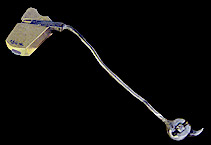
Fig. 23 (click to enlarge)
The hammer now wrongly planted.
The Royal clock's nearest comparables, Coster 'D8', has
the same general layout and very similar proud rivets to the four
pillars. Its diagonal strike lever is of thinner steel, its hammer is
all steel having a thick flat-stem to a rebated pear shape clapper
-needing no front plate cut-out, and also pivots along the plate from
right. Its long diagonal hammer spring
is set high on the left with a stubby stop-spring below. Coster D10 is
very similar but with a brass strike-lever.
Whereas the winder squares of both D8 and
D10 have unusual cross-pins at the front plate. <Compare Frontplates>
[Vertical hammer-posts first
appeared in 1659-1660, probably introduced by Hanet or Pascal, and soon
became the Franco-Dutch standard, even having a short lived English
manifestation with Fromanteel and his acolytes, including the famous
Samuel Knibb and renowned nephew Joseph Knibb, even Tompion].
Pf.066
●
Dial Mounted Bell.
[Fig.24]
The
undisturbed bell stand with its original high-domed heavy bell, is
mounted on the rear of the dial plate, on a beautifully crafted obelisk,
with the dome facing out like the two known striking clocks which bear
Salomon Coster's name.
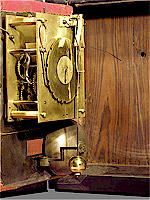
Fig. 24 (click to enlarge)
Bell on dial.
●
Split-barrel (Going and
Strike).
Overview.
The single advantage of the “going-barrel”, over the fusee system, is
uninterrupted power to its going-train on rewinding; it needs no
maintaining power but its varying force is uncompensated. Therefore,
historically, it was solely used for subsidiary trains, not for
timekeeping. The ancient spring-barrel evolved to drive two trains, I
give it nomenclature of ‘Split-Barrel’,
or pedantically,
‘Split-Subsidiary-Barrel’.
Certainly, this did not first appear during the mid-1650's,
coincident with Coster's new 'Haagseklok'.

Fig.
25 The split-barrel
Jost Burgi (1552-1632) of Kassel, (later Prague), is now credited with inventing the
first known
'split-barrel', driving separate Quarter and Hour trains in
his famous series of Globes, circa 1582.
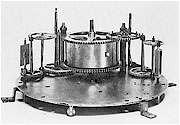
fig. 25a (click to enlarge)
Split-barrel in Burgi's (Anton Eisenhoit)
Armillarsphäre, 1585.
Nordiska Museet Stockholm.
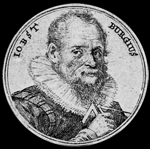
Jobst Burgi 1552-1632
Within Burgi's
Armillarsphäre, for Anton Eisenhoit circa 1585, is the
'split-barrel' he had
developed to drive two trains, striking Hours and Quarters.
(Acknowledgement to Nordiska Museet,
Stockholm).
Subsequently,
for decades, German clock makers used the split-barrel exclusively for
that purpose; never for going trains; the
Fusee alone reigned supreme in
their dominant City Guilds; In 1657/8, Philip Treffler of Augsburg even
added a fusee to Coster's
early going-barrel, as did
Bruce's sea-clocks (see 'Hollar' 1667).
Exactly
when, where and who adapted Burgi’s
split-striking-barrel for
Going and Striking is not known. Significantly, the
going-barrel, also its
variant the
split-going-barrel, were
only possible assuming an
erroneous premise that Galileo’s new pendulum, used in Huygens’ way, had
no need of regulated power. All Dutch and French makers relied on that;
but German, and English makers ultimately, did not. Fromanteel was one
of the first to use the going-barrel, then one of the first to re-divide
his trains, and barring Treffler was probably first to re-introduce the
fusee (with his spring maintaining power; being derived from his 1649
spring-remontoir).
It is almost written in stone, Salomon Coster made the first
Dutch pendulum clock, also the first to have strike work. His strikers, D8’ and ‘D10’, share Oosterwijck’s split-barrel. It became
ubiquitous in
Holland, French makers adopted it too but soon re-adopted multi-barrel formats,
like the English had before them, and both before the Dutch. Dr.Plomp
has the "tandem-barrel" as Coster’s contribution (Plomp R, “Prototypes”,
Op.Cit. p.202). That hypothesis would depend on the nature of his
supposed contribution.
Having
studied Oosterwijck's work, I now suggest that this seemingly mundane
device is actually fundamental to any understanding of ‘Hague-clocks’,
and very probably the Hague Contract of September 3rd,1657,
between Coster and Fromanteel, or
Fromanteel and Coster. In the light of Oosterwijck's construction,
Coster's priority must now be re-examined. I shall examine and consider
the
device as, potentially, the secret
device, and I will review the circumstantial evidence to discover
whose intellectual property it might be, and whose it is not, citing
'priorities' with all consequences. (See concluding Perspective, Nr.4)
●
Pendulum Applications.
Oosterwijck’s
split-barrel (diameter
4.3 cm,
2.5 cm
long), drives separate first-wheels for his
going and
strike trains.
Its weaker new mainspring (the clock’s
third) has thirteen turns but
just six are useable. That gives it a duration of 30 hours; or much
longer without strike.
(G1
has 72 teeth, S1 has 80 teeth).
Oosterwijck’s
new split-barrel has a deceptively simple appearance, showing bold
ratchet-work at the front. But, it is much more complex than is
apparent. Here I describe its parts, so that its underlying
characteristics and unique intellectual property is made clear.
Having
by this time already formed a considered view, that both of Coster’s
extant striking clocks are later than the subject clock, and on the
basis of features I shall disclose, this may well be the earliest "split-going-barrel" yet observed in any pendulum clock.
The going-wheel,
(G1, 72 teeth,
4.94 cm
diameter), is riveted onto the rear of the barrel. It drives the centre
pinion (6 leaves) with a shaped arbor having a centre-wheel (70 teeth)
at the front; unlike any of Coster's movements. The barrel's rearmost
cap has been left roughly filed.
The strike-wheel,
(S1, 80
teeth,
4.95 cm
diameter), forms a front cap, being pinned onto the squared arbor. A now
internal set-up ratchet is affixed to the wheel, unlike Coster’s
timepieces with ratchets set on the front plate. (Coster 'G5', early
Pascal timepieces and later Hague clocks set the ratchet-work onto the
back-plate). Oosterwijck’s 'split-barrel' appears to be conventional.
It is not!
● Ratchet-work.
[NL.Palrad, Ger.Sperrad,
Fr.Rochel,]. The
purpose of ratchet-work is to set up a
minimum spring tension, to get
a more equal mid-range force. Further, if a strike train is fitted, to
always reserve sufficient spring-power to operate the strike to the full
duration. Comparable Coster strikers, D8 and D10, have ratchets on the
front cap, behind the front plate. (Both have cross-pinned winder
squares - which at present I cannot fully explain without dismantling -
although one Van Ceulen has
its winder squares pinned to round barrel arbors].

Fig. 26 (click to enlarge)
Ratchet work
(view high res
picture)
The solid and seemingly ordinary strike-wheel (S1) forms
the front barrel-cap. Set proud, it mounts a thick circumferential
brass-spring to a steel click, engaging with the domed steel ratchet
(3.44cm, 21 teeth), secured by a stubby steel collar, having an unusual
'spur-cam', at the lower of
the two stepped squares below the winder.
This appears to be a typical split-barrel, having a typical
set-up ratchet and click pegged onto the barrel, like Coster D8 and D10,
but having no stop work. It is not!
●
Stop work.
[NL.Opwindbegrenzing,
Ger.Stellung,
Fr.Arretage,].
The
purpose of stop-work is to limit
spring tension and to prevent
over-winding, that might bind the spring or damage its attachments.
(Britten, FJ. “Watch and Clock- makers’ Hand- book
Dictionary and Guide”, SPON, 1938, p.415). If ratchet work were not
fitted, the stop alone might also 'fix' a range of travel for the going, and maintain minimum power for
strike if fitted.
Stop
work is not invariably found in all Hague clocks, although the earliest
extant Coster-Fromanteel ‘D1’ dated 1657 has it. Oddly enough, it is
most uncommon in French
derivatives. Yet this unremarkable device warrants a special survey, it
appears in Hague and
London clocks c.1657, but has a
long German ancestry.
German Origins.
Stop-wheels, early ones often shaped like a
'Maltese Cross', form an integral part of an ancient German craft
device to modify the force delivered by a spring barrel. the ‘Stackfreed’. That
combines a rotating barrel-cam, being limited by a stop-wheel, and
having a sprung roller-follower that manages spring forces delivered to
the train. (Baillie G.H., “Watches”,
Chap.5, Plate XIV, pp.84-85; also Bassermann-Jordan, “Book of Old Clocks and Watches”, 4th Ed. p.180, Fig.40b).
Much
later, Hans Keining adopts it to regulate his verge pallet depths and
incidence angles with spring power, (Lloyd H.A., “Old Clocks”, p.52
Fig.9). But Dr.Hans Von Bertele ascribes that clock to 1595, and he
attributes the original ‘adaptation’ to Keining’s master
Jost Burgi
(again), first
observed in his ‘aequating’
book-clock, circa 1591. (Bertele, Dr.H von, “Precision
Timekeeping in the pre-Huygens Era”, Horological Journal, BHI,
Dec.1953).
Sometime
later, either in the Hague or possibly in London, now without the cam
and its follower, the stopwheel is itself re-adapted to a new purpose;
not to manage power but to cut-off top-end torque and to prevent spring
derangements at clients’ hands; a desirable feature in any clock, but
especially in any destined for export.
When present, early Dutch stop-work usually takes the
typical form, with a visible stop wheel set onto the barrel-cap, being
turned by a pin or pinion on its arbor (see Plomp R, "Pendulums" Op.
Cit. Fig.55). Coster's successor, Pieter Visbagh, continued to use it.
A
curious variant may be seen in clocks by Christiaen Reijnaert, at
Leiden, Coster's last apprentice
who in 1660 was taken over by Pieter Visbagh, later to be his
brother-in-law. Reijnaert's stop wheel, often occupies the full radius
of large split-barrels. In this case 34+2 teeth engage a cross-drilled
barrel-arbor to a massive spring-barrel, as an integral pinion of
report, allowing eight turns for longer duration and more power.
Reijnaert's known examples have 'twin-click' ratchet work, sited at the
opposite end of his split-barrel.

Fig. 26a
Stopwork by
"Christiaen Reijnaert Leijdae Fecit".
[To digress, I am
only surprised whenever this form of arbor-pinion survives intact, but
several have. Relevantly, Coster's only alarum timepiece,
'D5,' with an external
bell, probably had a form of 'Reijnaert' stopwork, under Coster's aegis,
to maximise its duration; although it failed and was replaced with a
plain arbor, that did not replace the integral pinion nor stop-wheel.
Happily, it corroborates its Coster workshop pedigree, (see below, "Coster's
Clockmakers")].
Pf.073
●
Hidden Stp Work
Oosterwijck’s clock has already presented surprises; did it surprise Coster
too? On removing its front ring-collar, with the spur-cam, its combined
barrel-cap strike-wheel and ratchet, a hidden inner-cap is revealed. His
split-barrel's concealed inner-cap is mounted with diminutive 'watch'
stop-work, being unique
in my experience, at least in Hague clocks.
But why hidden in this fashion? Its construction is perplexing, it
raises challenging questions.

Fig. 27(click to enlarge)
Split barrel, ratchet and 'hidden stopwork'
This
stacked, hidden, arrangement is doubly unique, as, whenever ratchet work
and stop work are fitted, they 'always'
occupy the opposite ends of their barrel, or the ratchet work moves
onto either of the plates. I should like to know of another such
example, in any reader's experience.
Whatever
Oosterwijck’s intent, it was not for convenience of making. Might it be
a purloined secret, or have been constructed around Mayday 1658 when the
famous Contract terminated? Might it even be the actual model being
there described?
A
diminutive stop wheel, just 10.3mm, with six teeth cut (8 scribed),
permits six windings to the stop-sector, being driven by a pin set in
the barrel arbor, below stepped squares for the ratchet wheel and winder
key; Hague practice uses little taper to the winder square.
Riveted
to the inner-cap is a thin brass spring, possibly an afterthought, which
engages the stop as a simple click.
Oosterwijck’s barrel bears an indistinct cipher. If original, whose?
Are comparables similarly
marked?

Fig. 27a (click to enlarge)
The concealed stopwork.
[Coster's timepiece
'D3'
also has a pierced winding arbor, above its rare dovetail barrel-cap,
but that piercing is for the pin to secure the ratchet on the
front-plate, in common with his other timepieces].
●
English Variants.
Few
early English pendulum clocks
with going or split-barrels are
extant; excepting later clocks by English makers trading in
Holland, (Joseph Norris, Steven
Tracy, the Fromanteels, etc.). At
Appendix Three I identify several examples, but whenever striking is
added twin going-barrels are more typical of English work, (Fromanteels,
East, Bartram, etc.).
England's
hiatus of split-barrels might well reflect their abject failure as
timekeepers, especially when used for Fromanteel's pivoted pendulums,
which probably accounts for his much earlier readoption of the fusee and
his evident preference for weight clocks - as did Huygens. Both are
indicative of his 'test-discard'
approach, striving for better accuracy. Whereas, the Dutch makers stayed
with this basic '1657' pattern even into the 1690s, consequently
Holland fell far behind
England,
(see 'Concluding Perspectives', nr.
4).
Watch-stop
work, like Oosterwijck’s but lacking his spring, is seen on the front
barrel-cap of Fromanteel’s dated timepiece (c.1658); Simon Bartram’s
watch-clock has two similar, but on the back plate, for his separate
spring-barrels for going and strike, (c.1659). Both these have the new
five-wheel trains, for longer duration, probably a Fromanteel
innovation. Oosterwijck’s subject stop work relates more closely to
these than to Coster’s. Have these any relevance to dating Oosterwijck’s
clock, or to the Contractual ‘secreet’? Possibly. This should be
investigated and didactic arguments developed. (see, 'Secreet
Constructions').
But
who invented, or first adapted, simple stop work? And how did
Oosterwijck, Coster, also Ahasuerus Fromanteel in
London come to it? Is John Fromanteel the link for a
London origin? That invention's
history is vital to our understanding, (see
Concluding Perspectives, 4).
This technical aspect has never been properly addressed.
Taking a new account of this unique simple stop work,
and its split-going-barrel, admittedly first observed in the subject
Oosterwijck clock, we should now seek out comparable split-going-barrels also
stop-work in pre-Contract clocks.
Publication might well bring other unknown early clocks
back into the antiquarian domain, or, as already appears to be the case,
cause owners and custodians to revisit their charges to inspect them
with new keenness.
●
Wind-Me Mechanism?
The
curious much worn ‘spur-cam’, pinned to the barrel arbor at the first
stepped square, sets the most intractable puzzle. Paul Shrouder and I
considered its possible function. This barrel-cam appears to relate to
central pivots below the barrel, (now wrongly occupied by the hammer),
also relating to a reduced internal steel post, between the front plate
pivots. The evidence for the hammer being mis-planted; a hammer stop-pin
at its original pivot; the clapper now ‘bumped’ along its stem dovetail
to extend its reach; the angle of the front plate relief is for a more
upright hammer; the long ‘L’ spring is now awkwardly bent upwards, over the hammer-spur;
whereas formerly it extended along the plate to beneath the hammer spur.
Correcting the hammer position would clear those secondary pivots for
the lost feature. We considered a passing strike at half-hours, but the
well worn barrel-cam suggests otherwise.
The stop work of this 30-hour striking clock allows
six-windings of the spring, unwinding once every five hours on average,
but at irregular rates according to the hours being struck. Such an
irregularity precludes any feature that marks time, but would not
preclude the barrel spur tripping a detent to show the
state of winding also called
“up-down", often flagged on dials by "Wind Me".
●
Up-Down.
Cannot be shown on this dial; we dismissed the sector or even the centre
openings. And any device like Fromanteel’s globe-moon set upon the case,
at the two extant peg-holes, is not viable mechanically, (see Lee,
Ronald A. Op.Cit, Pl.92-97). The back plate offers no evidence.
This
is not resolved, but I proposed an hypothetical, also fully demountable
solution, which might be suspended below the movement, fixed to long
cocks from vacant sites on the front plate. It has one obvious drawback;
such a 'dial' would only be visible by lifting the dial signature plate.
My
fully demountable construction would be set on two long cocks at the
front plate on vacant studs and screw holes; one set just below the
winder, one above the ‘L’
spring. Investigation continues, better solutions are invited. For the
record, there are no plans to 'reconstruct' this hypothetical system.
 THE
UNIQUE BOX
CASE. THE
UNIQUE BOX
CASE.
●
Overview.
These early pendulums were popularly regarded as
being the panacea of timekeeping and the zenith of scientific
instruments. They were being rushed into production to meet eager new
domestic and international markets. I suggest, for that reason alone,
not any Calvinist or Puritan dogma, earlier fripperies were stripped
away. But an emerging French taste soon adorned these imported Dutch
cases, and their own derivatives, with new pediments, crestings,
mouldings, and even fine metal mounts. The two suspension eyelets (nl.
ophangers) are missing; later
strips set across the base steady the 'Mantle Clock' - as this Royal clock recently was addressed.
Externally,
Oosterwijck’s veneered ebony case looks exactly like Coster’s. (Fig.1
above). However, at just 25.4 x
21.0 cm, and
9.25 cm
deep, with a dial reveal of 20.7 x
16.2 cm, actually, it is smaller
than all known Costers, excepting 'D10'.
Oosterwijck's dial at 21.2 x
16.5 cm,
is one of the smallest known; and, in Hague clocks, smaller infers
earlier. In point of fact, might its true chronology antedate some
Coster-Fromanteel timepieces? Technically, I can see no technical reason
why not.
Show Wood Carcass. Whereas all of Coster’s
box cases are veneered onto deal, like the comparables and other Hague
clocks, (Fromanteel uses oak), Oosterwijck’s rare box appears to be
constructed from an expensive show-wood used in the solid.
Even
before opening the box, the most unusual, ‘full-span’,
backboard glows with its exotic hardwood carcass. Typically, Hague clock
carcasses are deal, veneered inside with Indian Rosewood (Dalbergia latifolia) or Padouk (Pterocarpus
spp) with Ebony veneers outside; their softwood backboards being set
within thick frames formed by the sides of the box.

Fig. 28 (click to enlarge)
The solid show wood back-board.
I knew this vivid hardwood as
Kingwood, (Dalbergia Cearencis);
several furniture experts have since concurred; but Howard Page suggests
Cocobolo–Dalbergia Retusa,
sourced from
South America.
Inside
and out, the backboard figuring is identical. However the sides might
require a more invasive examination, but where cut out for the sound
holes and pendulum arc they do seem to be solid, revealing Dalbergia’s
typical vivid ochre sapwood.
Probably,
Oosterwijck’s show-wood carcass of solid Kingwood is unique. Recalling
its Royal association, might his choice of ‘a Royal’ timber be a visual
and metaphorical pun? The opportunity to make invasive tests, including
timber density and species, is left to an appointed conservator who can
properly investigate.
Normally, such expensive woods are only ever seen as
veneers; as in Ahasuerus Fromanteel’s only slightly later three-month
long-case timepiece, (ex-Rous Lench, now in the British Museum; see
Appendix Three, Hollar 1667); also Samuel Knibb’s Royal longcase
with Kingwood veneered on oak. (Lee, R.A., Op.Cit., Pl. 91)*.

Fig. 28a
Samuel Knibb's Royal longcase clock
[* Formerly at
Windsor
Castle.
Ronald Lee repatriated this gem from
America.
It has Fromanteel's own maintaining power and his pivoted short pendulum
to a verge escapement, with a rare early quarter-strike train. I shot
these photographs at Mr Lee's galleries in
Bruton Place, just after this magnificent
Kingwood case had been beautifully restored by Mathew King. To Ronald's
chagrin, it soon returned to
America,
unhindered by petitions or legal barring].
●
The Construction.
Oosterwijck's simple box has no side
windows, an early feature that Coster abandoned with D10, in 1659. The
dial’s single winder gives us no clue to the presence of a new striking
train, but two fabric backed sound holes at the lower left corner
clearly denote its striking movement within.

Fig. 29 (click to enlarge)
The fabric backed sound holes
at the lower left corner denote its striking movement.
Similar
sound holes are also seen on the two extant Coster striking clocks, 'D8'
and 'D10', although not on the alarum timepiece, 'D5', which has its
bell mounted outside, above the case.

Fig. 30 (click to enlarge)
Thick veneers protrude around
its box to exclude dust.
The
clock winder key opens a sturdy internal lock at the large round hole on
the right (III ) face. The
lock releases the frame's flat brass staple, from the slot in the right
stile. A brass slider then unlatches the pinned dial, which swings open
with the movement attached, just as Coster arranged. The left stile is
chamfered to clear the pivoting dial.
The
case does
not require the furniture key of Coster's earliest spring-clocks, also
Van Ceulen's very finest commissions.
With
the movement exposed, its split-barrel and strike train are self
evident. The thick bell stands proud below the movement on the
IX side of the dial-plate, dome facing out, set on an obelisk
bell-stand.
The
dial plate is located into the box by two swivel-pins, held in wire
staples set below the veneers with ends just visible. The upper dial pin
is fixed to a flat plate riveted onto the dial. The lower dial pin-plate
has integral steady-pins, and is screwed to the dial after its pin has
been set into the recessed lower staple. This arrangement allows the
dial and movement to be demounted as a single unit.
Visible
outer faces of the
box case are veneered in thick sawn ebony; the forward edges are
mitred; bottom veneers overlap the side veneers, which overlap the top
veneers. Thick sides, (2.5 cm
including inner and outer veneers), have no inner returns but a small
rebate seats the dial. The dial latch has its own small recess.

Fig. 31 (click to enlarge)
Case chopped out for the pendulum.
Thick door stiles (2.5 cm
x
1.65 cm)
match the box, but are marginally larger because protruding veneer sills
overlap the box on three sides to exclude dust. Coster’s cases share
this feature; presumably by the same case maker, being yet more evidence
of these two makers cooperating.
The
lower right corner shows evidence of impact damage. The upper hinge is
fatigued, I advised its immediate repair. Paul Shrouder’s chosen glass
has nice irregularities; I took it as old. Thin brass hinges are set
with straps invisible under the facing veneers.
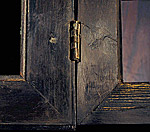
Fig. 32 (click to enlarge)
Everything
so far mentioned places this case in the earliest period, almost in a
class of its own. An accident has left its mark, the backboard split,
the hanging-eyes are lost, the door edge crushed, and its movement
‘ran-on’. Perhaps it fell, but these repairs are more recent than Huygens’
clocks that were crushed in book-piles during carriage to
Paris in 1664, (Plomp,
“Pendulums”, Op.Cit. p19).
Damage Control.
Unfortunately, some damage and alterations detract from the case's structure
and interior. The evidence
supports an accidental fall,
that also damaged its movement. The back board was split, and is now
filled and glued. Mismatched veneers front the dial-pins, where the
heavy movement broke away from its box at this weakest point, despite an
internal reinforcing staple. (Currently repaired with black stained
pine). The hangers are gone, probably capstans with small rings, or
one-piece eyelets, both their screw-holes are now capped off with plugs.
The backboard now has two holes drilled to secure it to the wall.
Abrasions
to the backboard testify to earlier repairs of the escapement. Sensitive
conservation is being recommended.
The
box’s inner faces are now chopped-out for a wider pendulum arc. Whether
for a King or a commoner, Severijn Oosterwijck would never have
despatched his exotic Kingwood and Ebony case in this state. [Note, the
inner sides of Coster D4's box are also scalloped out, but in neater
ellipses].
First
I assumed that some miscreant had failed to properly repair the once
damaged escapement, so he simply rebated the box for his wider arc. But
Paul Shrouder disabused me, saying ”the original amplitudes are never
bettered by later repairs”.
Berry Van
Lieshout suggests that the real culprits for these chopped-out side were
a stronger second spring
(replaced), probably with shortened pallets and re-cut escape teeth. [My
abstention from the bench has disadvantages].
Redundant wooden pegs are now set through the upper box.
On reflection, these probably supported a pediment or crest, added in
France
just before its putative arrival in
England
in June 1660. Dr.Plomp identified several of Claude Pascal‘s earliest
Hague clocks where his Dutch cases were similarly modified after their
arrival in Paris.
[Van Lieshout suggests these peg-holes might even be evidence for a Cardan
mount or gimbals, for use on board ship?
KP. I had not considered
that possibility; there are no pressure marks to indicate clamping
bolts, but a wide 'Knibb Phase 1' handle might, conceivably, have been
added, although I still incline to a pediment or crest. One of
Oosterwijck's sea-clock was damaged by a fall in December 1662, but they
were timepieces; they showed Seconds'; and they had fusees. However,
if
Berry is right about the extant
verge being an English repair, a different crutch might conceivably have
been removed; But why the pinholes
to the jaws of crutch? It
would suggest a later also a very different clock, and one having quite
another provenance. Here I do not anticipate any debate].
Beneath
and right across the box, two black-stained wood strips are roughly
nailed to steady the clock, reflecting its so called, “mantle clock” status.
●
Mortised Hinges.
Since I made my inspection, Philip Oliver was instructed to repair the
fatigued top hinge. Unfortunately he took no photographs, but he reports
that the hinges are not fixed square on the box or door. Each
hinge-plate is deeply rebated, into 45 degree mortises; ebony veneers
obscure that detail.
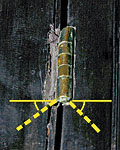
Fig. 32a
The hinge-plates are rebated
into 45 degree mortises, veneers obscure that detail.
This
aspect of original construction may assist researchers, and prompt
investigations into other early case construction techniques. [Berry Van
Lieshout informs me that he has already noted this form of hinge
construction]
Oosterwijck’s abused box may now be attended to by one
of today's most competent conservators, who can recover its original
beauty, once befitting a King. (see
Appendix Two).
 FIRST ASSESSMENTS.
FIRST ASSESSMENTS.
Certainly,
Oosterwijck’s Royal Hague clock proved more challenging than I had
anticipated. On first reading Paul Shrouder's article, I recalled
Huygens' price list of January 1659, to Boulliau in
Paris, which omits any mention of 30-hour spring clocks with striking. That
seemed to be a certain bar to earlier dating, but its Coster features
suggested 1659-1660 as a safe date; which I later found to coincide with
the family's extraordinary provenance.
Dr.Plomp
suggests that Oosterwijck and Visbagh did not make ‘prototypes’ before
Coster died in December 1659, (Plomp R, “Prototypes”, Op.Cit. p.203,
pf.2). Whereas he puts Oosterwijck's ‘D9’, also bearing the legend "Met Privilege", before Coster's ‘D10’. He was, then, unaware of
Oosterwijck's even earlier Royal clock. So, clearly, there remain
uncertainties, both about historical events and chronologies, which the
'open-research' project will address.
At
my own inspection, constructions not seen in another Hague clock sparked
associations to research long in hand with Mr 'Berry' van Lieshout in
Holland. We return to these subjects
as new evidence presents itself, as in this instance the
'Royal Haagseklok'.
Oosterwijck's
clock demonstrates the earliest use, and probably the only extant in any
Hague clock, of the split-going-barrel with a hidden stop-work. Dr Plomp
ascribes what he calls 'tandem-barrel' to Coster. But the ramifications
of his claim led me into uncharted historical waters, and eventually to
my concluding perspectives.
The
greatest of horology's early innovators, Jost Burgi of Kassel (later
Prague), first incorporated his original 'split-barrel'
in a series of mechanical Globes, circa 1582, to drive two strike
systems.
The
subject clock's split-barrel with
going and strike, surely, is an adaptation from Burgi, being in the
parlance of that time 'a new invention’. But how did Oosterwijck and
Coster come to it? With no English comparable now extant, evidentially,
it would appear to be a Dutch adaptation as Dr Plomp has claimed. But
was Coster or
Oosterwijck its Dutch ‘originator’? Who actually made or licensed the
craft ‘secreet’ that would be disclosed on Mayday 1658? And is the
split-barrel part of that secret?
After
long deliberations I now consider this clock to be a forerunner of its
type, made no later than 1658; if the dating of its extant comparables
can be relied on? Huygens' price list to Boulliau, dated
16th January 1659,
omits 30-hour spring-clocks with striking, but shows 8-10 day duration
weight clocks with striking.
Would a King choose a 30-hour clock if an 8-10 day clock was already
available? Therefore I should not be surprised if my provisional dating
were moved nearer to the time of signing the Fromanteel-Coster Contract,
on
September 3rd 1657, because striking clocks were long established and popular demand for
striking already existed at all social levels.
The
famous Notarial Akte (Contract) is somewhat obtuse, therefore I did
consider other scenarios. The split-going-barrel might be a reliable
work-horse, but it is also a
Chimera. Like its simpler going-barrel, it is not suitable for
precise timekeeping - even were it to indicate Seconds', no scientist
would use it. Huygens' experiments always used weight clocks, (see
below, "Hiatus of Seconds").
So was the split-going-barrel a commercial gimmick? In his own Patent
Application, on
9th
August 1658,
Simon Douw correctly identifies several defects of the Huygens-Coster
pendulum, also their spring and weight systems; evidently Douw was
neither a simple craftsman nor a sly plagiarist as Huygens' always
alleged!
Might another clockmaker, possibly even its true originator,
have understood or discovered the going and split-barrels' defects as a
timekeeper, then abandoned it on a Hague negotiating table to extract a
bigger prize? It is an aspect none have considered, and it certainly
makes for a rather more intriguing
three-cornered suit.
I became confident that Oosterwijck's Royal Hague clock was
made during Coster's lifetime and, very probably, it is the first of its
type now extant, antedating both Coster's D8 and D10. It also
demonstrates more clearly than words, just how Fromanteel's influence
extended deep into Coster's workshop, and perfectly explains the use of
an English word, 'secreet', in a Dutch Contract (3 September 1657). That
linguistic clue must assume a significant new role in resolving this
352-year old puzzle.
These opinions will
not sit well with all authorities, and may even be regarded as
controversial. I suggest we let open-research provide the evidential
base for an informed debate on the evolution of components and
chronology of Hague clocks. Only similarly thorough re-examinations of
all the extant comparables will suffice to fairly answer my hypotheses.
For
those who weigh conundrums, my
concluding perspectives
may confirm, entertain, challenge or even awaken interest in this
period.
Here, I leave behind the artefact, and embark on what I regard as its
more significant historical perspectives of context, with further
evidence and personal insights.
In the meantime, Mathew King has accepted
the challenge of carrying out the sensitive conservation work to
the furniture of the unique case. At this stage of conservation, the
distressed, later, inappropriate Indian-red velvet shall be left in
place until a census of experts agrees on replacement.
The first
fruits of Mathew King's conservation of the case furniture. The ebony
veneer at lock-slot is repaired, well selected Kingwood veneers now
conceal the chopped-out sides - but leaves the underlying evidence
intact for future investigators. These Kingwood veneer covers will be
thinned down before final fitting. (Image by courtesy of Mathew King).
 DIMENSIONS & CONSTRUCTION
(click here) DIMENSIONS & CONSTRUCTION
(click here)
PART II "OSCILATORIUM"
Perspectives & Hypotheses
 CONCLUDING PERSPECTIVES
(click here to view) CONCLUDING PERSPECTIVES
(click here to view)
Coster’s Other Contracts?
Makers of Coster Striking Clocks?
Fromanteel Connections?
Hidden ‘Secreet’ Constructions?
Personal Associations?
A Seconds’ Hiatus?
Claims to Priority.
 SEBASTIAN WHITESTONE'S DISCOVERY
(click here) SEBASTIAN WHITESTONE'S DISCOVERY
(click here)
Reflecting on the 1657 contract
 GENERAL
CONSERVATION
ISSUES
(click here) GENERAL
CONSERVATION
ISSUES
(click here)
Valuation?
Oosterwijck's Box Case
 OPEN RESEARCH PROJECTS
& MATRIX
(click here) OPEN RESEARCH PROJECTS
& MATRIX
(click here)
Significant early makers
Comparable Wheel Trains
Early Pendulum Clocks 'Matrices'
|
 |
 ACKNOWLEDGEMENTS
ACKNOWLEDGEMENTS
First I thank the private owners who kindly invited me to
examine their rare clock; also, in the first instance, the British
Horological Institute (BHI), for making contact with Paul Shrouder, also
Jayne Hall who promoted and edited publication of this review. Paul has
facilitated examination and answered my questions with helpful advice
and sketches, he also advised the BHI in production of this review.
Similarly, in
Holland,
Mr Fred Kats also made invaluable contributions, to bring this onto the
Horological Foundation website.
I thank all those whom I have cited in my review; especially
Drs Kees van Grimbergen, Carel Hofland and Pier van Leeuwen,
respectively the director, manager and consultant of Museum van het
Nederlandse Uurwerk at Zaandam, for providing records of wheel-trains
also images of two Coster clocks (D3, D8), with consent to use; would
that all museums held such records and were so co-operative. I am
indebted too to Sothebys'
Jonathan
Hills
for images and consents to show Coster timepiece (D3), and other clocks;
also to Christie's Jamie Collingridge for images and consents to show
Coster alarum (D5), and other clocks.
Dutch colleagues and friends, Hans van den Ende, Hans Kreft,
Ruud Mestrom, Berry van Lieshout, Dr Reinier Plomp; also Nicole Brandt
of the Nationaal Archief; each provided useful insights into other early
Hague clocks, also the Netherlands' history. David Thompson, Head of
Horology at the
British
Museum,
for images and train count of Bernard van Strijp's hybrid,
Antwerp,
Hague clock. Brian Walton, world pilot and solo-sailor, also old
squadron colleague, who gave
insights into basic longitude finding and relevance of 4-minute dial. I
must also acknowledge the late Ronald Lee and Peter Gwynn for their
encouragement, also the private owners of Samuel Knibb's Royal kingwood
longcase and of Van Ceulen clocks.
In anticipation, I thank Georgio Strano, Curator at the
Museum of the History of Science, Florence, who has kindly undertaken to
re-investigate Philip Treffler’s 1657 timepiece (DŘcopy); Alison Boyle
and Rob Skitmore of the Science Museum, London, for access and for
consent to publish Coster (D4); similarly to Simon Chesters-Thompson of
the National Trust also Tom Boggis, the House and Collections Manager at
Lyme Park, regarding the Ahasuerus Fromanteel timepiece dated 1658.
Finally I commend Dr.Elspeth Knights D.Phil. for proof reading my drafts
despite her unfamiliarity with
horology.
Museum Boerhaave,Leiden,
presently withholds train information or access to Coster timepiece (D1), on grounds that the museum is studying it themselves, with a
view to publishing an article. It is to be hoped that every custodian of
our heritage will now realise the advantage of 'open research' - also to
themselves and their organisations too.
●
Image copyrights:
Views herein reproduced or accessible as digital links are the legal copyright of
diverse persons or bodies, identified wherever possible; the copying of
any View is not permitted.
Figure 6a
is the legal copyright of Mr Paul Shrouder. Other
Figures whether published in printed or digital media or any other form or
distributed by any method, are claimed by the author, Keith Piggott, as
his legal copyright.
However,
in the interest of ‘open research’ (see Appendix Three), all
Figures herein may be used and be reproduced freely without the
express written consent of the copyright holder providing only that at
each use of an image the user shall acknowledge the copyright holder.
Figures may eventually be
upgraded by the author, when the same free license shall also apply.
However, any present or later upgraded
Views may not be
copied.
 BIBLIOGRAPHY
- SEVERIJN OOSTERWIJCK BIBLIOGRAPHY
- SEVERIJN OOSTERWIJCK
(before 1637-1690/94)
1. “Oeuvres Completes de Christiaan Huygens”, now available to all
researchers at the Biblioteque Nationale Francaise website
<http://gallica.bnf>.
2. Robertson, J Drummond, “The Evolution of Clockwork”, Chapt. IX,
Huygens and the determination of Latitude, p.149, p.154. (Cassell 1931)
.
3. Morpurgo E, “Nederlandse klokken- en horologemakers vanaf 1300” ,
p.94, (Scheltema & Holkema NV. 1970)
4. Plomp, R, “Spring-driven Dutch pendulum clocks 1657-1710”, pp.19, 28,
31-33, 37,38, 178-181 (Interbook International BV, Schiedam, 1979).
5. Cataloue “Horological Masterworks”, Museum of the History of Science,
Oxford,
(Antiquarian Horological Society, 2003)
6. Catalogue “Huygens’ Legacy”, Paleis Het Loo, Apeldoorn (Fromanteel
Ltd.2004).
7.
Vehmeyer, HM, “Clocks
Their Origin And Development 1320-1880”, (Snoeck, Gent 2004).
8.
Catalogue, "Octrooi op de Tijd",
Museum Boerhaave, Leiden 1979.
Copyright:
R.K.Piggott,
February 20, 2009.
(about R. K. Piggott)
APPENDICES
This article is subject to ongoing revisions. |






















































